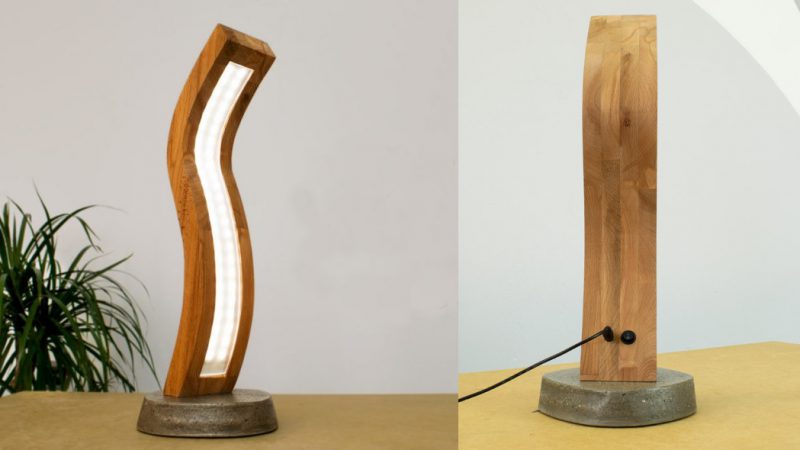Those of us who aren’t familiar with woodworking might not expect that this curved wood and acrylic LED lamp by [Marija] isn’t the product of fancy carving, just some thoughtful design and assembly work. The base is a few inches of concrete in a plastic bowl, then sanded and given a clear coat. The wood is four layers of beech hardwood cut on an inverted jigsaw with the middle two layers having an extra recess for two LED strips. After the rough-cut layers were glued together, the imperfections were rasped and sanded out. Since the layers of wood give a consistent width to the recess for the LEDs, it was easy to cut a long strip of acrylic that would match. Saw cutting acrylic can be dicey because it can crack or melt, but a table saw with a crosscut blade did the trick. Forming the acrylic to match the curves of the wood was a matter of gentle heating and easing the softened acrylic into place bit by bit.
Giving the clear acrylic a frosted finish was done with a few coats of satin finish clear coat from a spray can, which is a technique we haven’t really seen before. Handy, because it provides a smooth and unbroken coating along the entire length of the acrylic. This worked well and is a clever idea, but [Marija] could still see the LEDs and wires inside the lamp, so she covered them with some white tape. A video of the entire process is embedded below.
Remember the Heng lamp? Like [Marija]’s lamp it also demonstrated an intersection between wood, curves, and LED lighting. And of course, in no time at all an inspired hacker with a laser cutter had made his own copy.
















Saw cutting acrylic is trivial when you use the proper blade.
Wood cutting the curved shape is trivial when you use a band saw
Even if you don’t have the proper blade, there is a table saw technique that can yield good results, provided you are doing straight cuts and have a rip fence that allows for your desired finished width. You have to make several passes. The first pass has the tooth tips of the saw blade raised above the cutting surface to a height equivalent to about one fifth the thickness of the material you are cutting. After the first cut, raise the blade a bit and cut again. When you get just past the half-thickness point, lower the blade, flip the material, and repeat. This greatly reduces the likelihood of chipping and cracking, and any chipping that does occur tends to be toward the middle of the material thickness, where it’s both easier to sand out and better hidden.
Stellar work! It pays off though to just buy acrilyc that is fully satinated, then you get proper diffusion, even at such short distances.
yeah but then the satin finish will disappear when heating it up to bend
nice result, but i pretty much guarantee you the glue on the strip will not hold and they will come off after a few days.
So gluing everything together might come back to bite you, as you will need to get back in. The LEDs will also not live forever, and might die sooner than you think. (I’ve had strips die after only months) The electrical connections on the strips are also exposed, so when they come loose they might short circuit, always use heat shrink or electrical tape to insulate contacts, certainly if there’s a possibility they will move. Finally, opinions may differ on this, but always try to break the mains connection, as now the power supply is constantly ON (even without load), which will reduce its lifespan too.
This is nicely done! Reminds me that I have a steam bender lying around I’ve yet to use. Just a steam generator hooked up to a big piece of PVC pipe with caps and a little grille for wood to sit on. I’ve always wanted to try making organic shapes through steam bending.
Isnt masking tape atop LED strip a potential fire hazard? Nitpicky, she is gluing masking tape so replacing LED strip will be no so handy. If you want to blur LED light – sanding back side of acrylic is better way.
I would put the switch on the high voltage side. This way you get some constant current consumption, and depending on the quality of the transformer a fire hazard and hazard of electric shock. The transformer most probably does not like to be ON for years…